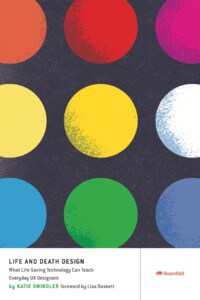A review of
 Life and Death Design
Life and Death Design
by Katie Swindler
Rosenfeld Media, LLC
248 pages, 8 chapters
About this book
A good reference for Methods/How-To, UX Theory, and Case Studies
Primary audience: Researchers and designers who are new or have some or significant experience with the topic
Writing style: Matter of fact
Text density: Mostly text
Learn more about our book review guidelines
The book Life and Death Design by Katie Swindler will be well received by those developing UX products and working in critical and stressful situations. These users not only include emergency workers but also everyday people who run into sudden crises like automobile accidents. “If you design your products assuming that people are only using them while in a calm frame of mind,” the author writes, “you may inadvertently create a product that fails to support your users in the moment they need it most.”
The beginning of the book provides an analysis of the human stress experience with a particular focus on the acute stress response in critical situations. It defines a path for the rest of the text by introducing readers to five responses to stressful events: 1) the startle reflex; 2) intuitive assessments; 3) the fight-flight-freeze reaction; 4) reasoned reaction; and 5) recovery.
Each section elaborates with tips and examples of how user interfaces can be designed to capture speedy and sudden reactions better in stressful situations. For example, the author states, “the best thing that technology can do when someone is in fight-or-flight mode is to protect them from harm and get them back to a rational state of mind as quickly as possible.” The text then suggests designing such things as exit/quit modes and immediate access to human contact as ways UX professionals can accomplish this goal. The text not only illustrates concepts with screenshots but also the biological characteristics of the stress response in the human brain and nervous system.
The text also discusses the body’s physiological response to the startle reflex, emphasizing how designers can shorten recovery periods from startle events. A safety tidbit: Stressful events like near-accidents freeze fine motor movement but leave large muscle groups functional. Therefore, cars should have knobs and buttons instead of touchscreens requiring fine motor movement with fingers. This is something to think about when purchasing your next car.
The text explores the role of intuitive decision-making. As with other parts of the book, the text includes ample references to and explanations of scientific and psychological processes and experiments in human cognition such as naturalistic decision-making (the process by which trained professionals rely on their first instincts to make critical choices), confirmation bias (the preference for attitudes and phenomena that confirm rather than challenge pre-existing beliefs), and the Superstitious Pigeon Experiment (a study conducted by B.F. Skinner that demonstrated how pigeons can develop superstitious behaviors when they associate random occurrences with subsequent rewards.) Real-world and live systems examples supplement the discussion (such as the Bodyswaps® VR simulator, which helps people improve interpersonal skills) to operationalize the book’s theoretical concepts and design principles.
The text discusses how the Fight-Flight-Freeze response plays into user interactions with interfaces, pointing out the specific case of a Robinhood™ user’s suicide after an interface misled them about a trade. The interface played a role in sublimating the user’s fight-flight reaction rather than providing opportunities to resolve matters with Robinhood staff. The authors also critique inaccessible access to 911 and other emergency help on mobile phones. Examples of story-based, step-by-step, and comic-strip interactions are discussed as reasoned-reaction solutions using the specific example of diagnosing heart attacks.
The section on recovery from Flight-Fight-Freeze discusses the physiological processes under which the body restores itself to equilibrium after a period of stress. The text provides helpful diagrams and a lucid explanation of the parasympathetic and sympathetic nervous systems. An interface for critical situations can assist stress recovery by including curved targets, watercolors, whitespace, and biophilic design incorporating elements of nature. Recognition of the cycle of stress, drive, action, and recovery process gives anxious users the opportunity for successful closure. This section’s references to scientific research are thorough and well-explained.
Alarms and alerts are frequently problematic in user interface design. In fact, while writing this review, Microsoft® Windows 365® frequently interrupted me with disabling alerts such as “OneDrive,” “User Verification,” and “Update Available/Restart now.” If the software engineers at Microsoft read Swindler’s book, they would learn that the best user interfaces give information in what the author calls “unobtrusive” ways. The text points out how too many poorly presented alarms and alerts can lead to far more critical outcomes than word processing interruptions. As a musician, I greatly appreciated the application of music theory to design, specifically applying the Devil’s Chord and the concept of musical intervals to the design of alarms and alerts. (The Devil’s Chord, also known as the tritone, is a dissonant musical interval consisting of three whole tones, often associated with an unsettling or ominous sound.) As elsewhere in the text, attention is also directed toward people with disabilities. For people with hearing loss, for example, it is suggested that audible alarms may be supplemented or replaced with tactile interfaces such as the Wayband® (a wrist-worn haptic device that helps users make their way around places without watching a screen).
The final chapter focuses on how to make users a “hero” when interacting with interfaces in crisis situations. Inspiring confidence and perseverance through encouragement coupled with training, professionalism, and applying the design principles provided in previous chapters leads to better outcomes. An example of similar heroism is given in the form of the response of engineers and scientists during the Apollo 13 mission.
The text is concise and well-written. Dense information is layered and presented well, with general overviews presented early and followed with greater detail. Readers are oriented within the text, so it’s easy to anticipate what information comes next. The author’s experience as a UX professional at Allstate™ and as a theater professional emerges in the unfolding, engaging narrative style of writing (including the concept of a hero UX practitioner) and by providing relevant examples from stage and screen. Complicated scientific concepts are broken down to make them understandable for a variety of audiences. In sum, this is an excellent book and highly applicable for any UX practitioner eager to learn neuroscientific principles and how to apply them to designing mission-critical systems.
Filipp Sapienza is a web developer, UX professional, and computational social scientist.

